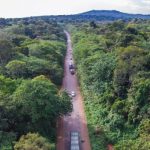Introduction Desertification, which affects around 45 percent of Africa’s land, is a growing concern with significant environmental and socio-economic impacts. The Regreening Africa initiative, spanning Ethiopia, Ghana, Kenya, Mali, Niger, Rwanda, Senegal, and Somalia, aims to restore 5 million hectares of land by 2030. This effort boosts biodiversity and supports local communities by leveraging local knowledge and resources to ensure context-appropriate interventions.
Uganda’s Environmental Context While Uganda is not officially part of the Regreening Africa initiative, it faces environmental challenges, including deforestation and land degradation. Uganda’s forest cover has decreased from 24% in 1990 to 9% in 2015 due to agricultural expansion, logging, and settlement. Recognizing these issues, Uganda has launched reforestation and land restoration projects.
Saudi Arabia’s Environmental Initiatives In contrast, Saudi Arabia, located in one of the most arid regions of the world, has embarked on ambitious projects to combat desertification and promote environmental sustainability. The Saudi Green Initiative aims to plant 10 billion trees within the country and rehabilitate vast tracts of degraded land. This initiative is part of Saudi Arabia’s Vision 2030, which includes significant investments in renewable energy and sustainable development.
Comparative Analysis
- Scale and Ambition:
- Regreening Africa: Targeting 5 million hectares by 2030 across multiple African countries.
- Saudi Green Initiative: Aims to plant 10 billion trees within Saudi Arabia, demonstrating a significant commitment to combating desertification in one of the world’s most challenging environments.
- Local Engagement and Knowledge:
- Regreening Africa: Emphasizes the importance of local solutions and knowledge, ensuring interventions are tailored to specific contexts. This approach leverages community participation and existing expertise.
- Saudi Green Initiative: While also focusing on sustainability, this initiative benefits from large-scale funding and technological advancements, but faces challenges in engaging local communities due to the region’s harsh climate and traditional lifestyles.
- Biodiversity and Ecosystem Restoration:
- Regreening Africa: Promotes biodiversity by restoring varied ecosystems, from savannas to forests, which support diverse flora and fauna and improve soil health.
- Saudi Green Initiative: Focuses on greening urban areas and creating green corridors, which can enhance biodiversity in urban settings and improve air quality.
Challenges and Opportunities
- Funding and Resources:
- Both initiatives require substantial financial investments. Regreening Africa often relies on international aid and partnerships, while Saudi Arabia leverages its wealth from oil revenues to fund environmental projects.
- Climate and Geography:
- Africa’s diverse climates and ecosystems pose unique challenges that require tailored solutions for each region. Saudi Arabia’s arid climate necessitates innovative approaches such as desalination and advanced irrigation techniques.
- Community Involvement:
- Engaging local communities is crucial for the success of both initiatives. In Africa, community-based approaches have proven effective in ensuring sustainable land management. In Saudi Arabia, changing traditional perceptions and practices is essential for long-term success.
Conclusion The Regreening Africa initiative and Saudi Arabia’s environmental projects highlight different approaches to combating desertification and promoting sustainability. While Africa’s efforts are characterized by community involvement and local knowledge, Saudi Arabia’s approach is marked by large-scale funding and technological innovation. Both regions can learn from each other’s experiences to enhance their environmental initiatives and create a more sustainable future.




